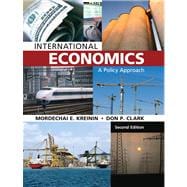International Economics: A Policy Approach, 2E provides a simplified yet comprehensive analysis of international economic relations, with the objective of extracting maximum policy insight from a minimum number of theoretical constructs.
Written for students with only one or two previous courses in the principles of economics, it is designed primarily as a basic text for a one- or two-term undergraduate sequence in international economics. However, the material is also arranged so that the theoretical sections may be omitted and the main text used as supplementary reading in policy-oriented non-economics courses, such as international relations or business administration. As domestic and global economies become ever more closely intertwined, world markets are an increasingly appropriate focus of study. International Economics: A Policy Approach gives students the conceptual tools they need to understand global economic relations.








